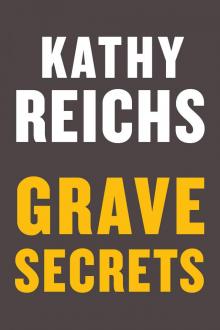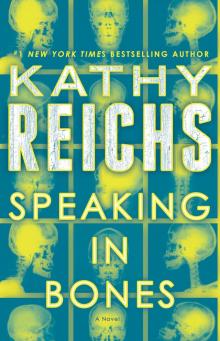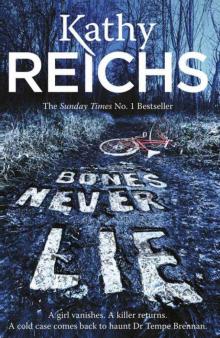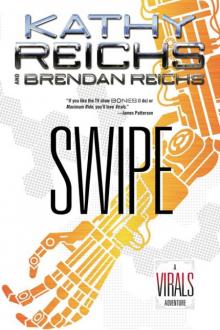- Home
- Kathy Reichs
Deadly Decisions Page 4
Deadly Decisions Read online
Page 4
Andrew Ryan was a criminal.
Emily Anne Toussaint was dead.
My daughter was somewhere on the Indian Ocean.
I often phone Katy when I’m feeling down, but for the past few months that had been difficult. She was spending her spring on Semester at Sea, circling the world aboard the S.S. Universe Explorer. The ship wouldn’t return for another five weeks.
I took a glass of milk to my bedroom and cracked the window and stared out, thoughts swirling like five o’clock traffic.
The trees and bushes looked like black shadows through the dark glistening mist. Beyond them I could see headlights and the shimmer of neon from the corner dépanneur. Now and then cars swooshed by, or pedestrians hurried past, their heels clicking on the wet sidewalk.
So routine. So normal. Just another rainy night in April.
I let the curtain fall back and crossed to my bed, doubting my world would return to normal for a very long time.
• • •
I spent the next day in constant activity. Unpacking. Cleaning. Shopping for food. I avoided radio and television, glanced only briefly at the paper.
The Gazette featured the Toussaint murder: SCHOOLGIRL KILLED IN BLOODY SHOOT-OUT. Beside the headline was a blowup of Emily Anne’s fourth-grade photo. Her hair was braided and bowed at both ends with large pink ribbons. Her smile showed gaps that adult dentition would never have the chance to fill.
The picture of Emily Anne’s mother was equally heartbreaking. The camera had caught a slim black woman with her head thrown back, mouth wide, lips curled inward in a cry of agony. Mrs. Toussaint’s knees were buckled, her hands clasped below her chin, and on either side, a large black woman supported her. Unspeakable grief screamed from the grainy image.
The story gave few details. Emily Anne had two younger sisters, Cynthia Louise, age six, and Hannah Rose, age four. Mrs. Toussaint worked in a bakery. Mr. Toussaint had died in an industrial accident three years earlier. Born in Barbados, the couple had immigrated to Montreal, seeking a better life for their daughters.
A funeral Mass would be celebrated Thursday at 8 A.M. at Our Lady of the Angels Catholic Church, followed by burial at the Notre-Dame-des-Neiges Cemetery.
I refused to read or listen to reports about Ryan. I wanted to hear from him. All morning I left messages on his machine, but got no response. Ryan’s partner, Jean Bertrand, had also gone incommunicado. I could think of nothing else to do. I was certain no one at the CUM or SQ would talk about the situation, and I knew none of Ryan’s family or friends.
After a trip to the gym, I cooked a dinner of chicken breasts with prune sauce, glazed carrots with mushrooms, and saffron rice. My feline companion would no doubt have preferred fish.
• • •
Monday morning I rose early, drove to the lab, and went directly to see LaManche. He was in conference with three detectives, but told me to talk with Stéphane Patineau as soon as possible.
Wasting no time, I headed down the corridor containing the offices of the medico-legal staff and the anthropology, odontology, histology, and pathology labs. Passing the Section des Documents on my left and the Section d’Imagerie on my right, I continued to the main reception area and turned left into the wing housing the administrative personnel of the LSJML. The director’s office was at the very back.
Patineau was on the phone. He waved me in and I took a chair opposite his desk.
When he finished his call, he leaned back and looked directly at me. His eyes were deep brown, hooded by heavy ridges and thick brows. Stéphane Patineau was a man who would never worry about thinning hair.
“Dr. LaManche tells me you want to get involved with the Toussaint investigation.”
“I think I could be of use to Carcajou. I’ve worked on several biker cases. Right now I’m sorting out the victims from the Vipers’ clubhouse bombing. I’m not new to this stuff. I cou—”
He waved a hand.
“The director of Opération Carcajou has asked if I could assign one of my personnel to act as liaison to his unit. With this war heating up he’d like to be sure the crime lab, the medico-legal staff, and his investigators are all on the same page at the same time.”
I didn’t wait to hear more.
“I can do it.”
“It’s spring. Once the river thaws and the hikers and campers hit the woods your workload is going to get heavier.”
That was true. The number of floaters and decomps always increased when the weather warmed and the past winter’s dead came to light.
“I’ll work overtime.”
“I was going to assign Réal Marchand, but you are welcome to give it a try. It’s not a full-time job.”
He lifted a paper from his desk and handed it to me.
“There is a meeting at three this afternoon. I’ll call to tell them you’re coming.”
“Thank you. You won’t regret this.”
He rose and walked me to the door.
“Is there a positive on the Vaillancourt brothers?”
“We’ll know once their medical records show up. Hopefully today.”
He gave a two-thumbs-up gesture.
“Go get ’em, Tempe,” he said in English.
I returned the gesture and he shrugged, then retreated to his office.
In addition to being a superb administrator, Patineau filled out a shirt more impressively than most bodybuilders.
• • •
Mondays are busy for every coroner and medical examiner, and this one was no exception. As LaManche went through the cases I thought the meeting would never end.
A young girl had died in the hospital and the mother admitted only to shaking her. Three years is beyond the age for Shaken Baby syndrome, and a contusion suggested the child’s head had been slammed against a hard surface.
A thirty-two-year-old paranoid schizophrenic was found with his stomach open, innards spewing onto the carpet of his bedroom. The family claimed the wound was self-inflicted.
Two trucks had collided outside St-Hyacinthe. Both drivers were burned beyond recognition.
A twenty-seven-year-old Russian seaman was found in his cabin with no signs of life. He was pronounced dead by the ship’s captain, and the body was preserved and brought ashore. Since the death occurred in Canadian waters, an autopsy was required.
A forty-four-year-old woman was beaten to death in her apartment. Her estranged husband was being sought.
Medical files had arrived for Donald and Ronald Vaillancourt. So had an envelope of snapshots.
When the pictures were passed around we knew that at least one twin lay in pieces downstairs. In a splendid Kodak moment Ronald Vaillancourt stood bare-chested, flexing his upper torso. The see-no-evil skull decorated his right chest.
LaManche assigned each of the autopsies to a pathologist, and turned the Vaillancourt documents over to me.
• • •
By ten forty-five I knew which twin had broken his fingers. Ronald “Le Clic” Vaillancourt had fractured his second and third left digits in a barroom brawl in 1993. The hospital X rays showed the injury in the same location as the irregularities I’d spotted on the metacarpals. They also showed that Le Clic’s arm bones lacked lines of arrested growth.
A motorcycle accident sent Le Clic back to the emergency room two months later, this time for hip and lower limb trauma. The radiographic picture was similar. Ronald’s leg bones were normal. His record also indicated he had been thrown from a car in ’95, stabbed in a street fight later that year, and beaten by a rival gang in ’97. His X-ray file was two inches thick.
I also knew who had not been a healthy kid. Donald “Le Clac” Vaillancourt was hospitalized several times during his childhood. As a toddler he experienced prolonged periods of nausea and vomiting, the cause of which was never diagnosed. At the age of six, scarlet fever nearly killed him. At eleven it was gastroenteritis.
Le Clac had also taken his lumps. His dossier, like his brother’s, contained a large packet of X
rays reflecting many visits to the trauma center. A broken nose and cheek. A knife wound to the chest. A blow to the head with a bottle.
As I closed the dossier I smiled at the irony. The turbulent life of the brothers would provide a diagram for sorting their bodies. Their many misadventures had left a skeletal map.
Armed with the medical files, I returned to the lower level and took up the parts identification process. I began with the tattooed segment of thorax and the fragments I’d associated with it. That was Ronald. He also got the fractured hand and all tissue containing normal long bones.
Limb bones with lines of arrested growth went to Donald. Limb bones without lines went to his brother.
Next I showed Lisa, one of the autopsy technicians, how to radiograph the remaining fragments with the bones in positions identical to those on the antemortem hospital films. This would allow me to compare details of shape and internal structure.
Since the X-ray unit was in heavy demand, we worked through lunch, finally quitting at one-thirty when the other technicians and pathologists returned. Lisa promised she would finish as the machine became available, and I hurried upstairs to change.
• • •
Opération Carcajou was headquartered in a modern three-story structure on the shore of the St. Lawrence River, directly across from Old Montreal. The rest of the complex was occupied by the port police and the administrative offices of the maritime authority.
I parked facing the river. To the left I could see the Jacques Cartier Bridge arching across past Île-Notre-Dame, to the right the smaller Victoria Bridge. Enormous chunks of ice floated and bobbed on the dark gray water.
Farther up along the shore, I noticed Habitat ’67, a geometric pile of residential space originally built for Expo and later converted to private condominiums. The sight of the building caused a constriction in my chest. Ryan lived in that network of boxes.
I pushed the thought from my mind, grabbed my jacket, and bolted for the building. The cloud cover was breaking, but the day was still raw and damp. An onshore breeze, carrying with it the smell of oil and icy water, flapped my clothes.
A wide staircase led to Carcajou headquarters on the third floor. Inside glass doors sat a stuffed wolverine, the totem for which the unit is named. Men and women occupied desks in a large central room, their extension numbers in block letters on signs above their heads. Framed clippings decorated every wall, stories of Carcajou investigators and their quarry.
Some looked up, most did not as I crossed to the secretary, a middle-aged woman with overdyed hair and a mole on her cheek the size of a June bug. She dragged her eyes from her filing long enough to direct me to a conference room.
I entered to find a dozen men seated around a rectangular table, several others lounging along the walls. The unit’s director, Jacques Roy, rose when he saw me. He was short and muscular, with a florid complexion and graying hair parted in the center, like the subject of an 1890s tintype.
“Dr. Brennan, we are so glad you’re doing this for us. It will be a great help to my investigators as well as to the folks at your lab. Please.” He gestured to an empty place at the table.
I hung my jacket over the back of the chair and sat. As others drifted in, Roy explained the purpose of the meeting. Several of those present had recently rotated on to the Carcajou team. Others were old hands, but had requested a refresher session. Roy would give a quick overview of the Quebec biker scene. When Constable Quickwater arrived he would report on the major case management session he’d attended at the FBI Academy.
It felt like a time warp. It was Quantico all over again, only this time the language was French and the carnage being described was in a place I knew and of which I was fond.
The next two hours revealed a world that few will ever know. That glimpse sent a shudder through my body and a chill into my soul.
“FIRST OF ALL, A LITTLE BACKGROUND INFORMATION.”
Roy spoke from the front of the room. He had notes on the podium, but didn’t use them.
“Outlaw motorcycle clubs began on the West Coast of the United States shortly after World War II. Some returning vets couldn’t adjust to the social requirements of peace and took to roaming the countryside on Harley-Davidsons, harassing the citizenry and generally making themselves obnoxious. They formed loose groups with names like the Booze Fighters, the Galloping Gooses, Satan’s Sinners, the Winos. Right from the start these guys weren’t candidates for the College of Cardinals.”
Laughter and muffled comments.
“The group to have the greatest impact was a collection of social misfits calling themselves the Pissed Off Bastards of Bloomington. The P.O.B.O.B. eventually became the Hells Angels, taking the name and the helmeted death’s-head symbol from a World War II bomber squadron. From the founding chapter in San Bernardino, California—”
“Yahoo, Berdoo.” A comment from the back.
“Right.”
“From that chapter the Hells Angels spread across North America. Eventually other groups also went national, then international. Today the big four are the Hells Angels, the Outlaws, the Bandidos, and the Pagans. All but the Pagans have chapters outside the States, though none to the extent of the Angels.”
A man sitting across the table raised his hand. He had a large paunch and receding hairline, and looked strikingly like Andy Sipowicz of NYPD Blue.
“How big are we talking here?”
“Figures vary, depending on the source, but the best estimate is that the Hells Angels have over sixteen hundred members throughout Europe, Australia, and New Zealand. Most are in the United States and Canada, of course, but, as of today, they have one hundred and thirty-three chapters around the globe.
“The 1998 Criminal Intelligence Service of Canada annual report estimates the Bandidos have sixty-seven chapters and about six hundred members worldwide. Other estimates bump it to eight hundred.”
“Sacrement!”
“What qualifies as an outlaw motorcycle club?” This questioner looked about nineteen.
“Technically the OMC label designates those clubs not registered with the American Motorcycle Association or the Canadian Motorcycle Association, the North American affiliates of the Fédération Internationale de Motocyclisme, now headquartered in Switzerland. According to the AMA, these nonregistered clubs account for only one percent of all motorcyclists, but it’s this deviant fringe that gives biking a bad name. And it’s a tag the boys have graciously accepted, by the way. I’ve seen the one-percenter logo tattooed on some of the ugliest shoulders in the province.”
“Yeah. The little triangle identifies the truly righteous biker.” The investigator to my right wore a ponytail and a silver stud in his ear.
“The truly rat puke, you mean.” Sipowicz. His French sounded exactly as I would expect if NYPD Blue had been set in Trois-Rivières.
More laughter.
Roy indicated a stack of notebooks in the center of the table.
“There’s information in those about the structure of OMCs. Read it and we’ll discuss it later. Today I want to take a look at the local scene.”
He clicked on a projector. The screen filled with the image of a clenched fist, swastika tattooed on the wrist, the letters F.T.W. in red and black rippling across the knuckles.
“The basic philosophy of outlaw bikers can be summed up in one phrase.”
“Fuck the World!” Shouted in unison.
“F.T.W. Fuck the World,” Roy agreed. “Your colors and brothers come first and demand total loyalty. Nonwhites need not apply.”
Roy clicked to the next slide. The screen showed a black-and-white photo of sixteen men arranged in three ragged rows. All were unshorn and wore sleeveless leather vests accessorized with pins and patches. Their tattoos would have impressed a Maori warrior. So would their scowls.
“At the end of the seventies the Outlaws and the Hells Angels from the States both partied hard with certain Quebec gangs they wanted to take over. In 1977 the Popeyes got ask
ed to the prom and became the first Hells Angels chapter in the province. At that time the Popeyes were the second-largest OMC in Canada, with 250 to 350 members. Unfortunately, only about 25 or 30 of the boys had impressed the Angels enough to wear the colors, so the rest got the boot. You’re looking at some of the rejects here. This is the infamous North chapter. Five of these guys were liquidated by their brother Angels and the chapter became extinct.”
“Why?”
“Each club has a code of conduct that applies to every member. Ever since the Hells Angels formed back in the forties their rules have prohibited heroin and the use of needles. This has become even more important in today’s business atmosphere. Keep in mind, these are not the bikers of old. This is not the social rebellion of the fifties, or the subculture of drugs and revolution that danced through the sixties. Today’s bikers are engaged in sophisticated organized crime. First and foremost these guys are businessmen. Junkies can cause trouble and cost the club money, and that isn’t tolerated.”
Roy gestured at the screen.
“Getting back to the choir here, in 1982 the Montreal chapter passed a drug law and called for death or expulsion of any Angel defying it. But the members of the North chapter were too attached to their coke, and decided to go their own way. Apparently the blow had affected their math, because they failed to note that they were strongly outnumbered on this question.”
One by one, Roy tapped his pen on five of the men in the photograph.
“In June of 1985 these guys were found taking the cement siesta in the St. Lawrence Seaway. One of the sleeping bags had floated up, the others had to be dredged from the bottom.”
“Taking care of business.” Ponytail.
“Permanently. They were killed in the Hells Angels’ clubhouse out in Lennoxville. Apparently the party they’d gone out there to attend turned out not to be the one they’d expected.”
“Kind of contrary to the old righteous brother outlaw doctrine.” Ponytail shook his head.

 Two Nights
Two Nights The Bone Collection: Four Novellas
The Bone Collection: Four Novellas Fatal Voyage
Fatal Voyage 206 Bones
206 Bones Bones to Ashes
Bones to Ashes Terminal
Terminal Monday Mourning
Monday Mourning Flash and Bones
Flash and Bones Cross Bones
Cross Bones Devil Bones
Devil Bones Break No Bones
Break No Bones Swamp Bones
Swamp Bones Déjà Dead
Déjà Dead Shock
Shock Spider Bones
Spider Bones Death Du Jour
Death Du Jour Grave Secrets
Grave Secrets Trace Evidence: A Virals Short Story Collection
Trace Evidence: A Virals Short Story Collection Bones on Ice
Bones on Ice The Bone Code
The Bone Code Bones in Her Pocket
Bones in Her Pocket Seizure:
Seizure: Speaking in Bones
Speaking in Bones Deadly Decisions
Deadly Decisions Spike
Spike Bones Never Lie
Bones Never Lie Bones of the Lost
Bones of the Lost Virals 03.5 - Swipe
Virals 03.5 - Swipe Exposure
Exposure A Conspiracy of Bones
A Conspiracy of Bones Shift (tory brennan)
Shift (tory brennan) Bones of the Lost: A Temperance Brennan Novel tb-16
Bones of the Lost: A Temperance Brennan Novel tb-16 Virals tb-1
Virals tb-1 Bones Are Forever tb-15
Bones Are Forever tb-15 Code tb-3
Code tb-3 Seizure tb-2
Seizure tb-2 Deadly Descisions
Deadly Descisions Spider Bones: A Novel
Spider Bones: A Novel